Click on images to enlarge
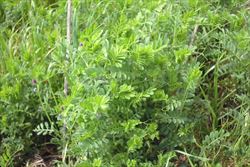
infestaiton (Photo: Sheldon Navie)

habit (Photo: Sheldon Navie)
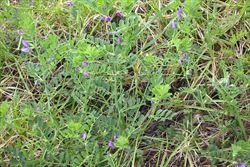
habit (Photo: Sheldon Navie)

alternately arranged once-compound leaves (Photo: Sheldon Navie)

leaf with relatively broad leaflets (Photo: Sheldon Navie)
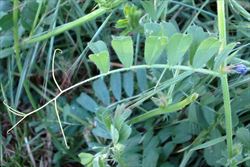
close-up of leaf from side-on (Photo: Sheldon Navie)
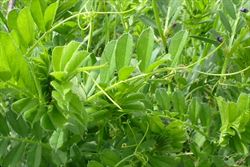
close-up of leaflets and tendrils (Photo: Sheldon Navie)
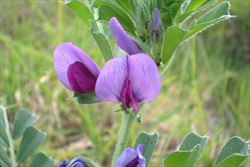
close-up of pea-shaped flowers with darker wing petals (Photo: Sheldon Navie)
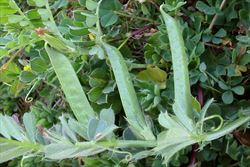
relatively broad immature fruit (Photo: Sheldon Navie)
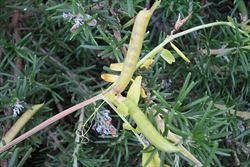
yellowish-brown mature fruit (Photo: Sheldon Navie)

close-up of seeds (Photo: Tracey Slotta at USDA PLANTS Database)

Vicia sativa 'Blanchefleur' (Photo: Sheldon Navie)
Scientific Name
Vicia sativa L. subsp. sativa
Synonyms
Vicia sativa L.Vicia sativa L. var. sativa
Family
Fabaceae (Queensland, the ACT, Victoria, Tasmania, and the Northern Territory)Fabaceae: sub-family Faboideae (New South Wales)Leguminosae (South Australia)Papilionaceae (Western Australia)
Common Names
common vetch, garden vetch, golden tare, grain vetch, pubescent common vetch, spring vetch, tare, vetch
Origin
Common vetch (Vicia sativa subsp. sativa ) is widely cultivated and naturalised throughout the world and its exact native range obscure. However, it is thought to be native to parts of Europe and Asia.
Cultivation
Common vetch (Vicia sativa subsp. sativa) is widely cultivated as a pasture legume in the temperate regions of Australia. Some cultivars are also grown to produce grain for animal consumption. The two cultivars that are most common in cultivation are 'Blanchefleur', with white flowers, and 'Languedoc", with violet-purple flowers. A newer rust-resistant variety (i.e. 'Morava') is also becoming more commonly cultivated.
Naturalised Distribution
Widely naturalised in Australia, but most common and widespread in the southern parts of the country (i.e. in many parts of New South Wales, in the ACT, Victoria and Tasmania, in the south-eastern and southern parts of South Australia, and in south-western Western Australia). Occasionally also naturalised in the cooler parts of south-eastern Queensland.
Also widely naturalised in North America (i.e. Canada and the USA).
Habitat
A weed of crops, wetlands, watercourses, open woodlands, grasslands, roadsides, disturbed sites, waste areas, gardens and pastures in temperate and occasionally also sub-tropical regions.
Habit
A short-lived (i.e. annual) herbaceous plant with creeping (i.e. prostrate), scrambling or climbing stems growing 0.3-1.2 m tall.
Distinguishing Features
- a short-lived herbaceous plant with slender creeping, scrambling or climbing stems.
- its alternately arranged leaves are once-compound and there is a pair of small leafy structures at the base of each leaf stalk.
- these leaves (2-10 cm long) have two to seven pairs of leaflets (18-27 mm long and 5-10 mm wide) and usually end in one or more tendrils.
- its pink or purple pea-shaped flowers (1.8-3 cm long) are borne singly or in small clusters in the upper leaf forks.
- its elongated and flattened pods (3-7 cm long and 6-12 mm wide) are usually somewhat hairy when young and turn brown or yellowish-brown when mature.
Stems and Leaves
The slender stems range from being hairy to almost hairless (i.e. pubescent to glabrous) and reach up to 1 m long.
The alternately arranged leaves are once-compound (i.e. pinnate) and borne on short stalks (i.e. petioles) 2-4 mm long. There is a pair of small toothed, leafy, structures (i.e. stipules) 3-8 mm long at the base of each leaf stalk. These leaves (2-10 cm long) have two to seven pairs of oblong or narrowly egg-shaped (i.e. obovate) leaflets and usually end in one or more tendrils. These leaflets (18-27 mm long and 5-10 mm wide) are hairy (i.e. pubescent) with entire margins and shortly-pointed tips (i.e. apices truncate or emarginate and apiculate).
Flowers and Fruit
The pea-shaped flowers are borne singly or arranged in small clusters in the upper leaf forks (i.e. in axillary racemes). These flowers (1.8-3 cm long) are borne on short stalks (i.e. pedicels) 1-4 mm long or are almost stalkless (i.e. sub-sessile). Each flower has five green sepals (9-22 mm long) that are fused together at the base into a tube (i.e. calyx tube) and five pink or purple petals. The larger uppermost petal (i.e. standard) are usually paler that the two side petals (i.e. wings), and the two lower petals are fused together and folded (i.e. into a keel). The flowers also have ten stamens and an elongated ovary topped with a short style and stigma. Flowering occurs mainly during winter and spring (i.e. from July to November).
The elongated and flattened pods (3-7 cm long and 6-12 mm wide) and distinctly constricted between each of the seeds (i.e. slightly torulose). They are usually somewhat hairy (i.e. pubescent) when young and turn from green to brown or yellowish-brown in colour as they mature. Each of these pods contains 6-12 rounded to slightly oblong seeds (3.5-6.5 mm across).
Reproduction and Dispersal
This species reproduces by seed, which may be dispersed by water or in contaminated agricultural produce (e.g. fodder and pasture seeds).
Environmental Impact
Common vetch (Vicia sativa subsp. sativa) is regarded as an environmental weed in Victoria and Western Australia.
Legislation
Not declared or considered noxious by any state government authorities.
Similar Species
Two other sub-species of common vetch (Vicia sativa) are also naturalised in Australia, narrow-leaved vetch (Vicia sativa subsp. nigra) and Vicia sativa subsp. cordata. These can be distinguished from each other by the following differences:
- common vetch (Vicia sativa subsp. sativa) has relatively broad leaflets (5-10 mm wide) and relatively large flowers (17-30 mm long). Its pods are relatively broad (6-12 mm wide) and turn yellowish-brown when mature.
- narrow-leaved vetch (Vicia sativa subsp. nigra) has relatively narrow leaflets (1-4 mm wide) and relatively small flowers (8-18 mm long). Its pods are relatively narrow (4-6 mm wide) and turn dark brown or blackish when mature.
- Vicia sativa subsp. cordata has relatively broad leaflets (10-15 mm wide) and relatively large flowers (18-26 mm long). Its pods are relatively narrow (4-6 mm wide) and turn dark brown when mature.

